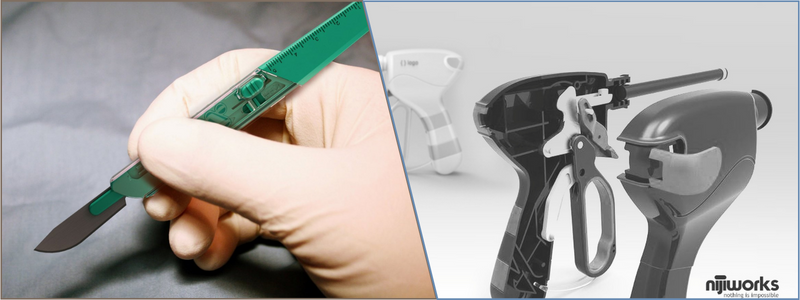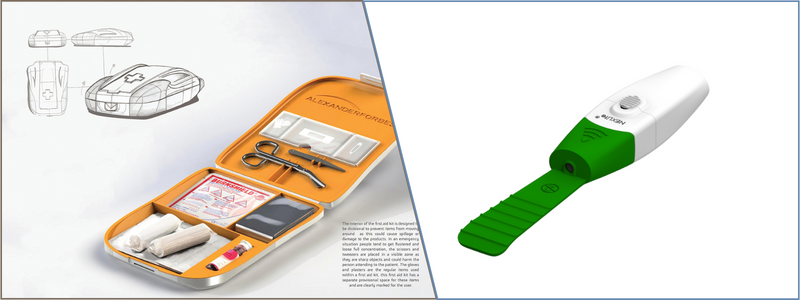Millions of lives are saved annually due to innovative medical devices. With the help of rapid prototyping services, companies can produce innovative medical products quickly. It is one of the best things that reliable design firms can do. Medical technology advancements can enhance the quality of care, diagnosis accuracy, and more, from surgical and laboratory equipment to prosthetics and pacemakers.
 Table of Contents
Table of Contents
- Medical device prototyping defined.
- Importance of prototyping in the development of critical new medical devices
- Existing options for medical prototyping
- Other 3D printing options
- Prototyping new medical devices
- How to add prototyping to the critical new medical device development process
- How Cad Crowd can assist
Medical device prototyping defined.
Thomas Edison said he didn’t fail but only discovered 10,000 ways that don’t work, and this quote can be related to creating prototypes for new products. The prototyping process involves creating a basic product version for conceptualization and visualization. Prototypes fall into two primary categories: functional and non-functional prototypes.
- Functional prototypes – allows people to get a better sense of the basic functionality and form of the product. An example of a functional prototype in today’s medical devices is an electrosurgical receptacle and connector that can power up and transmit data when connected.
- Non-functional prototypes – are used to give users non-digital representations of products. For example, a 3D printed receptacle and connector that doesn’t transmit power or data but visually demonstrates product design is a non-functional prototype.
In medical device prototyping, it is critical to remember that functional prototypes aren’t ready for market use. A functional prototype is not the final product; instead, it is a working example helpful in developing an improved finished product. You can enlist the help of an experienced medical device design & development agency to bring your idea to market.
RELATED: Manufacturing materials for medical devices
Importance of prototyping in the development of critical new medical devices
The prototyping process assures the readiness of new products for the market – design for assembly professionals can help. With the development of prototypes, developers can test a product’s viability, ensure that it adheres to regulatory standards, meet its core objectives and more. Even though prototyping is vital to any business before large-scale production and distribution, it is even more imperative in the medical industry.
It doesn’t matter if your idea aims to boost the efficiency of surgical procedures or enhance the overall quality of life, and prototyping can help pinpoint possible risks in advance. Prototypes can also foster seamless collaboration, and a tangible model can make it easier for teams to collaborate, determine shortcomings and discover advancement potential.
RELATED: How to make a prototype for your new product design
Existing options for medical prototyping
Medical device prototypes can be developed in various ways. The specific prototyping method depends on whether you prefer a non-functional or functional device prototype. The following is an overview of the standard prototyping techniques used for electrical device prototypes:
3D printing
3D printed prototypes are often non-functional and used to conceptualize a design. The increasing popularity of 3D printing design services has accelerated the production and development of device prototypes. It is ideal for teams that rely on frequent and quick iterations to move their designs forward to the device development process.
RELATED: What is 3D printing? A beginner’s guide
3D printing enables almost any geometry or shape items can be made from an electronic data source or 3D models like the computer-aided design or CAD file and AMF or additive manufacturing file. Here are the most popular types of 3D printing used for medical devices:
- Fused Deposition Modeling – This is where plastic layers are made using a thermoplastic method.
- Stereolithography – converts liquid material into solid parts through photopolymerization and layering.

Other 3D printing options
CNC machining
A CNC programming company often uses CNC or computer numerical control machining for more advanced prototypes that require a specific material and tight tolerances. Developing a CNC machine prototype involves using CNC mill-coded instructions to shape a solid block of plastic or metal.
RELATED: The advantages and disadvantages of CNC machining for prototype design
Laser Cutting
Laser cutting can be a practical choice for metal prototypes that require a smooth and precise finish. The process used a high-output laser and coded program to shape the material, usually metal, to a particular geometry.
Photochemical machining (PCM) or photo etching
PCM is the process where chemical milling is used for machining away specific parts of the sheet metal corrosively to form a part. As for medical device prototyping, PCM is beneficial for the low-cost creation of metal prototypes.
Screw machining
Screw machining can be helpful in the later phases of the development process to give people a better sense of what they will experience after the product’s release. The process involves running metal through the screw machine to produce precision prototypes for the connector pins. Screw machining paired with machined equipment is feasible to present a connector’s authentic feel, function, and look.
RELATED: 3D printing technologies for modeling and prototyping
Prototyping new medical devices
Product development is a process that requires several steps. Every step builds on the last step until the product reaches the final stop on its development journey. The following phases may be included for medical devices:
Initial concept
All designs begin with product and concept design services. Digital renderings, mock-ups, and initial drawings offer a rough idea of what the specific method is meant to achieve. It is also a stage that often comes with fundraising initiatives, a business plan, and other necessary measures that might help gauge the interest of investors. It also guides the design from the development to the finished product.
RELATED: How 3D printed prosthetics are changing lives
POC or proof of concept
POC prototypes are mock-ups that help research and development teams during the development cycle. The build evaluates the idea’s feasibility and the design’s usability. While it might not resemble the final product, the model presents critical components to assist product development designers in idea visualization.
Alpha Prototype
Alpha prototypes look and work almost the same as the finished product and are critical in the refinement of the design. It is an iteration that provides a complete appearance. It offers the development team to present value to the stakeholders and acquire feedback on safety concerns, possible flaws, and other primary elements.
RELATED: 6 Ways you can use 3D printing services to create a new prototype design
Beta prototype
Beta prototypes are the next generation of design. Depending on the information acquired from the earlier alpha prototype, the beta prototype implements feedback in molds, enclosures, subassemblies, production tooling, and other primary features. It is a build developed using more advanced manufacturing methods for fostering a better and more complete sample. It is the point when the design is ready for preliminary validation, performance and safety testing, and early clinical trials.
Pilot prototype
Pilot prototypes resemble the final product more closely than the previous beta build. Depending on the feedback from the beta stage, a pilot prototype is made using the same material and design specifications. It makes these prototypes more appropriate for soft product launches, further clinical trials, FDA submission, and other essential steps that the final design needs.
RELATED: How to design the best prototype for your new product

Final production
The final product is the point when the process of manufacturing starts. The product has combined the feedback from the earlier phases to reach its full maturity. The assembly and design processes are stable and streamlined while fostering high yields. Following the final product launch, the feedback in the post-market analyses may lead to further refinements to address any concerns.
Although every step in this process is essential, it can be expensive and time-consuming without a reliable partner for manufacturing. From the initial quote to the last iteration, prototype engineering experts have the expertise to help in the efficient tackling of complicated projects and stick to crucial deadlines during the process.
RELATED: How much do manufacturing services cost for your company prototypes, products & new parts?
How to add prototyping to the critical new medical device development process
Medical prototyping has evolved over the past two decades, and it is possible to create prototypes efficiently. Developing new medical device prototypes requires knowledge of the various prototyping options, material science, design controls, and other fields. But developing prototypes that let you strategically test and validate your design may be a bit challenging. For this to be possible, prototyping should be incorporated into the development process. The rapid prototyping methods that combine precision with short lead times will bring revolutionary medical devices to market faster.
How Cad Crowd can assist
Our design experts can review your existing designs or start a new one from scratch, ensuring that all your requirements and specifications are met and that your product can be made at the lowest manufacturing cost. By hiring Cad Crowd freelancers, you’ll have experts who work on your product design process and leave you free to focus on other tasks. It’s a great way to ensure product quality while simultaneously reducing costs and growing your business! Contact us for a free quote today.
